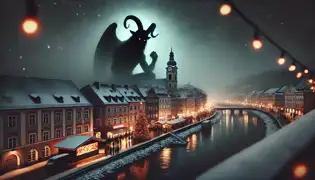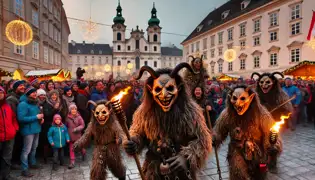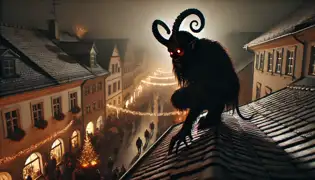The Linzer Krampus
Reading Time: 6 min

About Story: The Linzer Krampus is a Fable from austria set in the Contemporary. This Descriptive tale explores themes of Good vs. Evil and is suitable for Young. It offers Cultural insights. In Linz, the Krampus is more than just a myth—he’s come back to claim what’s his.
The people of Linz tell their children to be good, to listen to their parents, to respect their elders. Not just because it's the right thing to do, but because someone—or something—is always watching.
It’s an old belief, one wrapped up in the traditions of Christmas, in the jingling bells of Saint Nicholas and the festive glow of holiday lights. But beneath that warmth lies a darker legend, a presence lurking in the deep December nights.
The Krampus.
Unlike Saint Nicholas, who rewards the good, the Krampus is a creature of reckoning. He is a beast of tangled fur and twisted horns, with a grin that stretches too wide and a sack slung over his shoulder—not for gifts, but for stolen children.
Most think of him as a myth, a fairytale whispered to keep little ones from misbehaving. But not everyone believes he's just a story.
And one winter, in the city of Linz, the Krampus became real. December came with an unforgiving chill. Snow had arrived before its time, sweeping over the rooftops and freezing the Danube into a solid, glistening sheet. The Christmas market should have been bustling by now, full of warmth and life, but something was different this year. People spoke in hushed tones. The streets emptied early. There was an unease in the air, thick as the frost that coated the windows. Maria Seidel felt it too. As a journalist for *Linzer Nachrichten*, she had covered her fair share of strange local stories—folklore festivals, unexplained sightings, the occasional missing person. But never before had she encountered a story like this. It started with a child, Lukas Vogl, who vanished on his way to visit a friend. He was seven. Then a baker, Herr Bauer, an old man who had lived in Linz his whole life and had never once left his shop unattended—until the night he did. Then a teenage girl. Three disappearances in a week. No signs of struggle. No footprints leading away. And the only clue? The whispers of those who had heard something unnatural. The scrape of claws on cobblestone. The distant clang of chains. A deep, growling breath that carried on the wind. Maria wasn’t the type to believe in legends. But she knew fear when she saw it. And the people of Linz were afraid. The night of the Krampuslauf was supposed to be a time of revelry. A night when costumed men ran through the streets as horned beasts, delighting and terrifying children in equal measure. A tradition meant to keep the legend alive. But this year, something felt off. Maria stood in the Hauptplatz, her camera slung around her neck, watching as the parade wound its way through the square. The Krampus figures stormed past, their masks grotesque, their movements wild and frenzied. She had grown up with this tradition. She had laughed as a child when they rattled their chains, screamed in pretend terror when they chased her. But tonight, the fear in the air wasn’t pretend. It was real. And then the first scream tore through the crowd. Not a child’s giggle. Not a playful shriek. A raw, gut-wrenching cry of terror. Maria turned, her camera already in her hands, and saw the woman collapse, pointing toward the rooftops. Her breath caught in her throat. Perched on the edge of a building, silhouetted against the firelight, was a figure too tall, too hunched, too wrong to be a man in costume. Horns curled like a ram’s. A thick, matted hide of fur covered his body. His eyes gleamed, reflecting the torchlight like an animal’s. Not a man. Not a mask. Something else. Then, in the space of a blink, he was gone. By the next morning, Maria’s hands still trembled when she poured her coffee. The photograph sat on her desk. Blurred but unmistakable. A hulking figure, monstrous and real. She needed answers. She found them in a place few ever looked—in the archives of the old city records, buried beneath centuries of dust and neglect. She wasn’t the first to chase this legend. The name *Krampus* appeared again and again, not just in folktales but in police reports. Strange disappearances. Unexplained sightings. But one document stood out. A confession—a priest’s account from nearly two centuries ago. *"We made a bargain,"* it read. *"For the town to survive, we had to give him what he demanded. The wicked. The unwanted. But when we tried to deceive him—when we took the innocent instead—he swore he would never forgive us. That he would return."* Maria felt the weight of those words press down on her chest. The Krampus was no mere legend. He was part of the city’s past. And now, he was part of its present. Maria knew there was only one way to stop him. The records spoke of a way to break the cycle. A chance to undo what had been done. The Krampus was hunting. And she had to find his next target before he did. The search led her to the abandoned outskirts of the city, where the wind howled through empty alleyways and the snow had long gone untouched. Then she saw him. Lukas. The missing boy, huddled in the snow, his eyes wide with terror. And behind him—towering in the darkness—the Krampus. A wave of pure, animal panic washed over Maria. The beast’s breath steamed in the cold air, his fingers flexing, sharp and black as claws. She had no weapons. No plan. Just her camera. Heart pounding, she raised it. Clicked the shutter. The flash exploded in the night—blinding, white-hot. The Krampus reared back with a snarl, his form flickering like a shadow caught between worlds. Maria lunged forward, grabbing Lukas, her legs moving before she could think. She ran. Through the empty streets, through the frozen dark, until the lights of Linz surrounded them once more. She didn’t look back. By the time they reached the town square, he was gone. The curse, at last, was broken. The disappearances stopped. The city woke from its nightmare. But Maria still dreams of him. Of horns curling in the dark. Of chains rattling just beyond sight. And on the coldest nights, when the wind howls through Linz… She swears she hears a whisper.The Frost Comes Early

The Krampuslauf

The Hunt Begins

The Final Night of Winter
Epilogue
"Not yet."

















